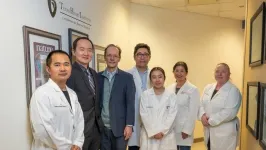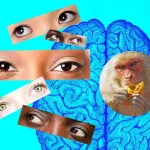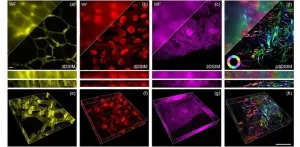(Press-News.org) In a first of its kind study, researchers have identified significant differences between the diversity of gut bacteria in grey squirrels compared to red squirrels which could hold the key to further understanding the ability of grey squirrels to outcompete red squirrels in the UK.
New research, published in the Journal of Medical Microbiology, looked to understand more about the mechanisms by which grey squirrels are able to gain an advantage over red squirrels. Chris Nichols, Conservation Evidence Manager at the Woodland Trust, and co-author of the study, said:
“The more we know about grey squirrels, the more equipped we’re going to be in the future to tackle the threats they pose to red squirrels and our native trees, which is one of the biggest problems for forest conservation in the UK.”
Grey squirrels are an invasive, non-native species introduced from North America to sites in Great Britain and Ireland between 1876 to 1929. They out-compete the native red squirrels and multiply thanks to various traits including their ability to access a broader range of food sources including the bark of UK broadleaved trees. This causes significant damage to the trees, and is a behaviour that, prior to this research, was not completely understood.
To learn more about what gives grey squirrels an edge over red squirrels, researchers collaborating from the Woodland Trust, University of Surrey, University of Bangor and the Animal and Plant Health Agency analysed the gut microbiota of the two species. The diversity and abundance of the microbes that make up the gut microbiota (microbes living within a particular environment - in this case the squirrel gut) is often an indicator of the diet, level of health and immunity of an individual.
Researchers sampled bacterial DNA from the gut contents of red and grey squirrels and performed DNA sequencing to identify the bacterial groups present in the two species. They then compared the results to identify any key differences.
They found significant differences in the diversity of gut bacteria between the two types of squirrels, with grey squirrels having a more diverse range of microbiota in their gut.
Lead author of the study Professor Roberto La Ragione, Professor of Veterinary Microbiology and Pathology at the University of Surrey, explained: “Red squirrels are now an endangered species in the UK. Not only are grey squirrels larger and more robust than red squirrels, we have now identified a significant difference in their gut bacterial microbiota, potentially giving them another advantage over reds.”
This increased diversity in the grey squirrel gut microbiota could indicate improved general health and immunity compared to red squirrels. It could also reflect the grey squirrel’s broader diet, but crucially the difference between the two sample groups provides researchers with valuable information on the way in which grey squirrels are able to access a broader range of resources.
Researchers also identified the presence of oxalate-degrading bacteria in the guts of grey squirrels which means it is likely that they can digest calcium from tree bark and may explain the destructive bark stripping behaviour of the grey squirrels.
As this research was a sample of only UK red squirrels researchers hope that future research could look to mapping the gut microbiota of other native red squirrel populations across Europe to understand more.
Chris Nichols is optimistic about the implications of these findings. “More research needs to be done to further understand the relationship between red and grey squirrels and their gut microbiota, but perhaps in the future we could develop this research into methods that could promote healthy gut bacteria in red squirrels or new ways of preventing squirrels from damaging trees.”
Professor Ian Brown OBE, Animal and Plant Health Agency Director of Scientific Services, said: “These findings will help further our understanding of the impact grey squirrels have on the UK’s red squirrel population and our vitally important trees and forests, which will in turn help us understand how best to protect them in the future.
“I am proud of APHA’s important work on this issue in partnership with the Microbiology Society, Woodland Trust, University of Bangor and the University of Surrey.”
END
Scientists are unravelling the secrets of red and grey squirrel competition
2024-02-15
ELSE PRESS RELEASES FROM THIS DATE:
Targeting the microenvironment rather than a specific cell type could be the key to healing injured hearts
2024-02-15
A groundbreaking scientific study published in Nature Cardiovascular Research has unveiled a remarkable discovery that may have far-reaching implications for the treatment of heart disease.
The intensive investigations utilizing single-cell genomics and genetic experiments were conducted by a team of renowned scientists in the Cardiomyocyte Renewal Laboratory and McGill Gene Editing Laboratory at The Texas Heart Institute, including James F. Martin Vivian L. Smith Chair in Regenerative Medicine and Vice Chairman and Professor ...
Live from the brain: Visual cues inform decision to cooperate
2024-02-14
HOUSTON – (Feb. 14, 2024) – Eye contact and body language are critical in social interaction, but exactly how the brain uses this information in order to inform behavior in real time is not well understood.
By combining behavioral and wireless eye tracking and neural monitoring, a team of Rice University scientists and collaborators studied how pairs of freely moving macaques interacting in a naturalistic setting use visual cues to guide complex, goal-oriented cooperative behavior. The study published in Nature offers first evidence that the part of the brain that processes visual information ⎯ the visual cortex ⎯ plays an active role in social behavior by providing ...
Super-resolution microscopy harnesses digital display technology
2024-02-14
In the ever-evolving realm of microscopy, recent years have witnessed remarkable strides in both hardware and algorithms, propelling our ability to explore the infinitesimal wonders of life. However, the journey towards three-dimensional structured illumination microscopy (3DSIM) has been hampered by challenges arising from the speed and intricacy of polarization modulation.
Introducing the DMD-3DSIM System
Enter the high-speed modulation 3DSIM system “DMD-3DSIM,” combining digital display with super-resolution imaging, allowing scientists to see cellular structures in unprecedented detail. As ...
UW anthropologists’ research unveils early stone plaza in the Andes
2024-02-14
Two University of Wyoming anthropology professors have discovered one of the earliest circular plazas in Andean South America, showcasing monumental megalithic architecture, which refers to construction that uses large stones placed upright with no mortar.
Located at the Callacpuma archaeological site in the Cajamarca Basin of northern Peru, the plaza is built with large, vertically placed megalithic stones -- a construction method previously unseen in the Andes. Associate Professor Jason Toohey, project lead, and Professor Melissa Murphy have been researching ...
New epigenetic clocks reinvent how we measure age
2024-02-14
BOSTON – What causes us to age? New “clocks” developed by researchers may help point to the answers. Investigators from Brigham and Women’s Hospital, a founding member of the Mass General Brigham healthcare system, unveil a new form of epigenetic clock – a machine learning model designed to predict biological age from DNA structure. The novel model distinguishes between genetic differences that slow and accelerate aging, predicts biological age and evaluates anti-aging ...
The roles of USP1 in Ewing sarcoma
2024-02-14
“This study uncovered important roles for USP1 in Ewing sarcoma.”
BUFFALO, NY- February 14, 2024 – A new research paper was published in Genes & Cancer on February 5, 2024, entitled, “Roles of USP1 in Ewing sarcoma.”
Ewing sarcoma is a cancer of bone and soft tissue in children and young adults that is driven by the EWS-ETS fusion transcription factor, most commonly EWS-FLI1.
Researchers Panneerselvam Jayabal, Xiuye Ma and Yuzuru Shiio from The University of Texas Health Science Center previously reported that Ewing sarcoma harbors two populations of cells, ...
New algorithm disentangles intrinsic brain patterns from sensory inputs
2024-02-14
Maryam Shanechi, Dean’s Professor of Electrical and Computer Engineering and founding director of the USC Center for Neurotechnology, and her team have developed a new machine learning method that reveals surprisingly consistent intrinsic brain patterns across different subjects by disentangling these patterns from the effect of visual inputs.The work has been published in the Proceedings of the National Academy of Sciences (PNAS).
When performing various everyday movement behaviors, such as reaching for a book, our brain has to take in information, often in the form of visual input — for example, seeing where the book is. Our brain then has to process ...
A new test could predict how heart attack patients will respond to mechanical pumps
2024-02-14
Every year, around 50,000 people in the United States experience cardiogenic shock — a life-threatening condition, usually caused by a severe heart attack, in which the heart can’t pump enough blood for the body’s needs.
Many of these patients end up receiving help from a mechanical pump that can temporarily help the heart pump blood until it recovers enough to function on its own. However, in nearly half of these patients, the extra help leads to an imbalance between the left and right ventricles, which can pose danger to the patient.
In a ...
Turning back the clock on photoaging skin
2024-02-14
Chronic exposure of human skin to ultraviolet light causes premature aging, or photoaging. As the skin undergoes photoaging, type I collagen bundles, which are found in the dermis beneath the top layer of the skin and provide strength and support to skin, become fragmented. This leads to wrinkles, fragility and loss of support and elasticity.
“The best way to prevent damage to type I collagen by sunlight is to wear sunscreen consistently, daily if possible and particularly when spending time outdoors,” said Frank Wang, MD, the William B. Taylor Endowed Professor of Clinical Dermatology at U-M Medical School.
Experts ...
City of Hope research featuring the successful treatment of the oldest patient to achieve remission for leukemia and HIV published in The New England Journal of Medicine (NEJM)
2024-02-14
LOS ANGELES — City of Hope®, one of the largest cancer research and treatment organizations in the United States, treated the oldest person to be cured of a blood cancer and then achieve remission for HIV after receiving a blood stem cell transplant from a donor with a rare genetic mutation. Research published in NEJM today demonstrates that older adults with blood cancers who receive reduced intensity chemotherapy before a stem cell transplant with donor cells that are resistant to HIV may be cured of HIV infection.
Paul Edmonds, 68, of Desert Springs, California, is the fifth person in the world to achieve remission for acute myelogenous leukemia ...





